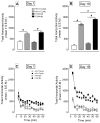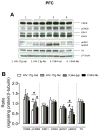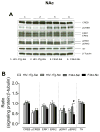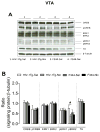Genetically expressed HIV-1 viral proteins attenuate nicotine-induced behavioral sensitization and alter mesocorticolimbic ERK and CREB signaling in rats
- PMID: 21420997
- PMCID: PMC3091851
- DOI: 10.1016/j.pbb.2011.03.013
Genetically expressed HIV-1 viral proteins attenuate nicotine-induced behavioral sensitization and alter mesocorticolimbic ERK and CREB signaling in rats
Abstract
The prevalence of tobacco smoking in HIV-1 positive individuals is 3-fold greater than that in the HIV-1 negative population; however, whether HIV-1 viral proteins and nicotine together produce molecular changes in mesolimbic structures that mediate psychomotor behavior has not been studied. This study determined whether HIV-1 viral proteins changed nicotine-induced behavioral sensitization in HIV-1 transgenic (HIV-1Tg) rats. Further, we examined cAMP response element binding protein (CREB) and extracellular regulated kinase (ERK1/2) signaling in the prefrontal cortex (PFC), nucleus accumbens (NAc) and ventral tegmental area (VTA). HIV-1Tg rats exhibited a transient decrease of activity during habituation, but showed attenuated nicotine (0.35mg/kg, s.c.)-induced behavioral sensitization compared to Fisher 344 (F344) rats. The basal levels of phosphorylated CREB and ERK2 were lower in the PFC of HIV-1Tg rats, but not in the NAc and VTA, relative to the controls. In the nicotine-treated groups, the levels of phosphorylated CREB and ERK2 in the PFC were increased in HIV-1Tg rats, but decreased in F344 animals. Moreover, repeated nicotine administration reduced phosphorylated ERK2 in the VTA of HIV-1Tg rats and in the NAc of F344 rats, but had no effect on phosphorylated CREB, indicating a region-specific change of intracellular signaling. These results demonstrate that HIV-1 viral proteins produce differences in basal and nicotine-induced alterations in CREB and ERK signaling that may contribute to the alteration in psychomotor sensitization. Thus, HIV-1 positive smokers are possibly more vulnerable to alterations in CREB and ERK signaling and this has implications for motivated behavior, including tobacco smoking, in HIV-1 positive individuals who self-administer nicotine.
Published by Elsevier Inc.
Figures







Similar articles
-
Environmental enrichment alters nicotine-mediated locomotor sensitization and phosphorylation of DARPP-32 and CREB in rat prefrontal cortex.PLoS One. 2012;7(8):e44149. doi: 10.1371/journal.pone.0044149. Epub 2012 Aug 31. PLoS One. 2012. PMID: 22952905 Free PMC article.
-
Intra-ventral tegmental area HIV-1 Tat1-86 attenuates nicotine-mediated locomotor sensitization and alters mesocorticolimbic ERK and CREB signaling in rats.Front Microbiol. 2015 Jun 19;6:540. doi: 10.3389/fmicb.2015.00540. eCollection 2015. Front Microbiol. 2015. PMID: 26150803 Free PMC article.
-
Nicotine mediates expression of genes related to antioxidant capacity and oxidative stress response in HIV-1 transgenic rat brain.J Neurovirol. 2016 Feb;22(1):114-24. doi: 10.1007/s13365-015-0375-6. Epub 2015 Aug 26. J Neurovirol. 2016. PMID: 26306689 Free PMC article.
-
Expression profile of nicotinic acetylcholine receptor subunits in the brain of HIV-1 transgenic rats given chronic nicotine treatment.J Neurovirol. 2016 Oct;22(5):626-633. doi: 10.1007/s13365-016-0438-3. Epub 2016 Apr 7. J Neurovirol. 2016. PMID: 27056721 Free PMC article.
-
Tribute to: Self-administered nicotine activates the mesolimbic dopamine system through the ventral tegmental area [William Corrigall, Kathleen Coen and Laurel Adamson, Brain Res. 653 (1994) 278-284].Brain Res. 2016 Aug 15;1645:61-4. doi: 10.1016/j.brainres.2015.12.064. Epub 2016 Feb 8. Brain Res. 2016. PMID: 26867702 Review.
Cited by
-
Transcriptome sequencing of gene expression in the brain of the HIV-1 transgenic rat.PLoS One. 2013;8(3):e59582. doi: 10.1371/journal.pone.0059582. Epub 2013 Mar 25. PLoS One. 2013. PMID: 23536882 Free PMC article.
-
Environmental enrichment alters nicotine-mediated locomotor sensitization and phosphorylation of DARPP-32 and CREB in rat prefrontal cortex.PLoS One. 2012;7(8):e44149. doi: 10.1371/journal.pone.0044149. Epub 2012 Aug 31. PLoS One. 2012. PMID: 22952905 Free PMC article.
-
The effects of HIV-1 regulatory TAT protein expression on brain reward function, response to psychostimulants and delay-dependent memory in mice.Neuropharmacology. 2016 Oct;109:205-215. doi: 10.1016/j.neuropharm.2016.06.011. Epub 2016 Jun 15. Neuropharmacology. 2016. PMID: 27316905 Free PMC article.
-
Characterization of neuropathology in the HIV-1 transgenic rat at different ages.J Neuroimmunol. 2016 Mar 15;292:116-25. doi: 10.1016/j.jneuroim.2016.01.022. Epub 2016 Feb 3. J Neuroimmunol. 2016. PMID: 26943969 Free PMC article.
-
The HIV-1 transgenic rat model of neuroHIV.Brain Behav Immun. 2015 Aug;48:336-49. doi: 10.1016/j.bbi.2015.02.020. Epub 2015 Feb 27. Brain Behav Immun. 2015. PMID: 25733103 Free PMC article. Review.
References
-
- Anagnostaras SG, Robinson TE. Sensitization to the psychomotor stimulant effects of amphetamine: modulation by associative learning. Behav Neurosci. 1996;110:1397–1414. - PubMed
-
- Berger JR, Arendt G. HIV dementia: the role of the basal ganglia and dopaminergic systems. J Psychopharmacol. 2000;14:214–221. - PubMed
-
- Berridge KC. The debate over dopamine’s role in reward: the case for incentive salience. Psychopharmacology (Berl) 2007;191:391–431. - PubMed
Publication types
MeSH terms
Substances
Grants and funding
LinkOut - more resources
Full Text Sources
Miscellaneous

